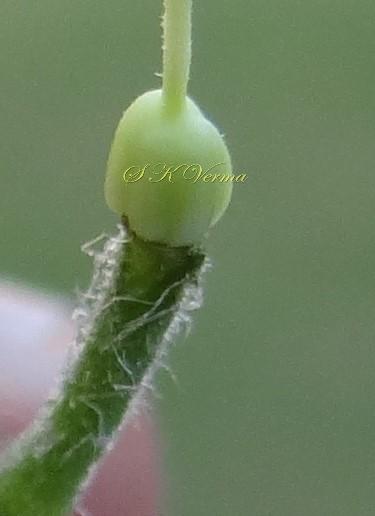SOLANUM
Solanum
L., Sp. Pl. 1: 184. 1753; Gen. Pl. ed. 5. 224. 1754; Collett, Fl. Siml.ed. 2: 341. 1921 (Reprint 1980); Clarke in Hook.f., Fl. Brit. India 4: 229. 1885; Cooke, Fl.Pres. Bomb. Reprint ed. 2: 331. 1967; Hawkes & Edmonds in Tutin et al., Fl. Eur.3: 197. 1972; Matthews, Fl. Tamilnadu Carn. 1: 1057. 1983; Fl. China @eFloras.org 17: 314; Nasir, Fl. Pak. @ eFloras.org p. 1.
Herbs, shrubs, climbers or small trees, sometimes prickly; hairs simple or branchedor stellate, sometimes glandular. Leaves alternate or opposite, simple or pinnatelycompound, mostly petiolate; leaf blade entire, dentate, lobed or parted.Inflorescences axillary, extra-axillary or leaf-opposed, mostly racemose,paniculate, umbellate, fasciculate or flowers solitary; pedunclebranched or not, sometimes obsolete. Bracts absent. Flowers mostly actinomorphic, bisexual orandromonoecious (Male and bisexual flowers on the same plant), often 5-merous, hypogynous. Calyx small, campanulate, 5-lobed, mostlylobed partway, persistent. Corolla mostly rotate; tube very short; limb spreading, 5-lobed, folding at angles. Stamens inserted high in corolla tube, exserted; anthersoblong, acute, coherent in a projecting cone around style, dehiscing by apical pores(often later splitting longitudinally). Ovary 2-5-locular with enlarged (swollen)placentas; ovules numerous per loculus, placentation axile; style long; stigma small. Fruitingcalyx persistent, sometimes enlarged and enclosing berry. Berries mostly juicy.Seed discoid or lenticular
1234 species
Solanum lycopersicum
Solanum lycopersicum
L., Sp. Pl. 1: 185. 1753; Lycopersicon esculentum Mill., Gard. Dict. ed. 8. 820. 1768; Clarke in Hook. f., Fl. Brit. India 4: 237. 1885; Bailey, Stand. Cyclop. Hort. 2: 1931. 1919; Kaur & Sharma, Fl. Sirmaur 452. 2004; Fl. China @ eFloras.org 17: 329; Nasir, Fl. Pak. @ eFloras.org p. 21; L. lycopersicum (L.) H. Karst., Deut. Fl. 966. 1882.
Annual, erect or sprawling herb, up to 2 m tall, branched, aromatic. Pubescence of double small and large, simple or glandular hairs. Leaves alternate, 10-40 cm long; petiole 2-6 cm long; mostly imparipinnately compound with terminal leaflet longest, 1-2-pinnatifid with few small interstitial leaflets; both surfaces pubescent, veins prominently hairy abaxially; leaflets 5-9, opposite or alternate, sessile or petiolulate, petiolules 6-15 mm long, pubescent, leaflets mostly ovate-lanceolate, subacute, irregularly dentate or lobed, subcordate at base, apex acute. Inflorescence axillary cyme, often 3-7-flowered; peduncle 2-5 cm long, little or not branched. Flowers 1-1.8 cm long and 2-3 cm across, ebracteate, actinomorphic, bisexual, 5-8-merous, hypogynous, yellow; pedicels ca. 7 mm long, pubescent. Calyx 7-8 mm long, rotate-campanulate; lobes 5-6, 5-10 mm long, linear-lanceolate, hairy without. Corolla 2-2.5 cm in diameter; rotate, lobes 5-6(-8), narrowly oblong or triangular, acute or acuminate, 8-10 mm, often reflexed, yellow; tube +/- equal to lobes, pilose without. Stamens 5 or 6, inserted in corolla tube near throat; filaments very short, 1-1.5 mm long; anthers 6-10 mm long, coherent, attenuate and long apiculate at apex, apical part ca. 3 mm long, narrow, attenuate, apiculate and sterile, together forming a cone, yellow; dehiscence longitudinal. Ovary 2-5-locular, placenta swollen, many ovules per loculus, placentation axile; style filiform, 1-2 cm long, ovary and basal part of style hairy; stigma capitate. Fruit a many-seeded berry; berry brick-red, red to yellowish, globose, depressed-globose to pyriform, sometimes lobed, up to 8 cm in diameter. Seeds 2-4 mm in diameter, discoid, glabrous or pubescent or pilose.
Common Names: Tomato; Tmaatar (Hindi)
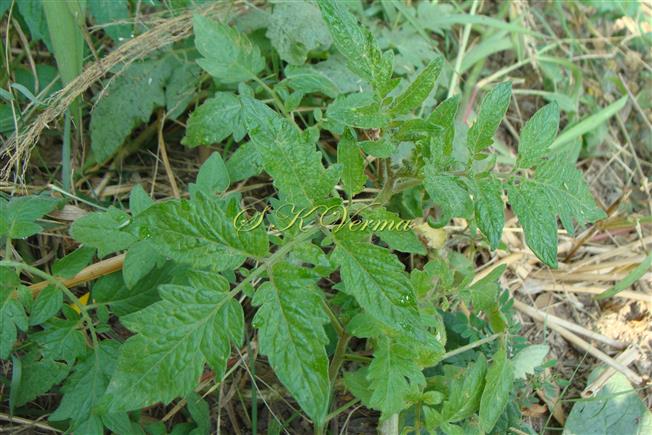
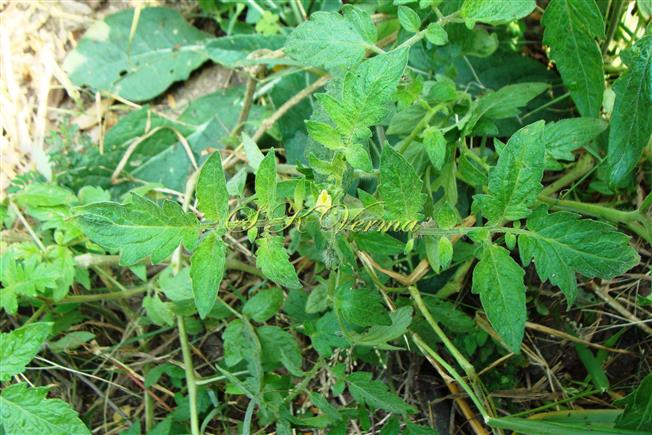
-DSC04117.jpg)
-DSC04115.jpg)
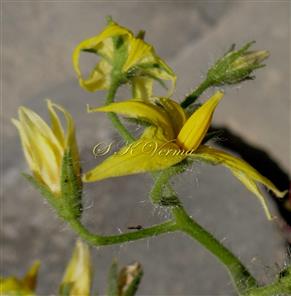
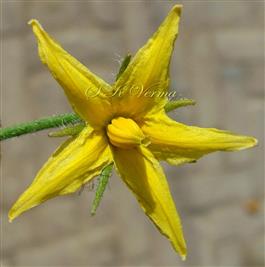
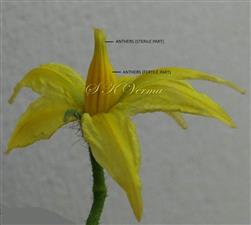
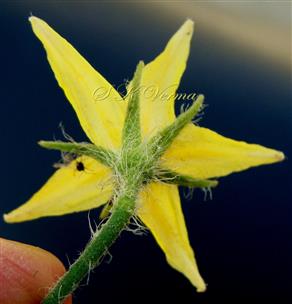
-DSC04170.jpg)
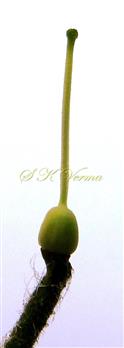




-DSC04117.jpg)
-DSC04115.jpg)




-DSC04170.jpg)

